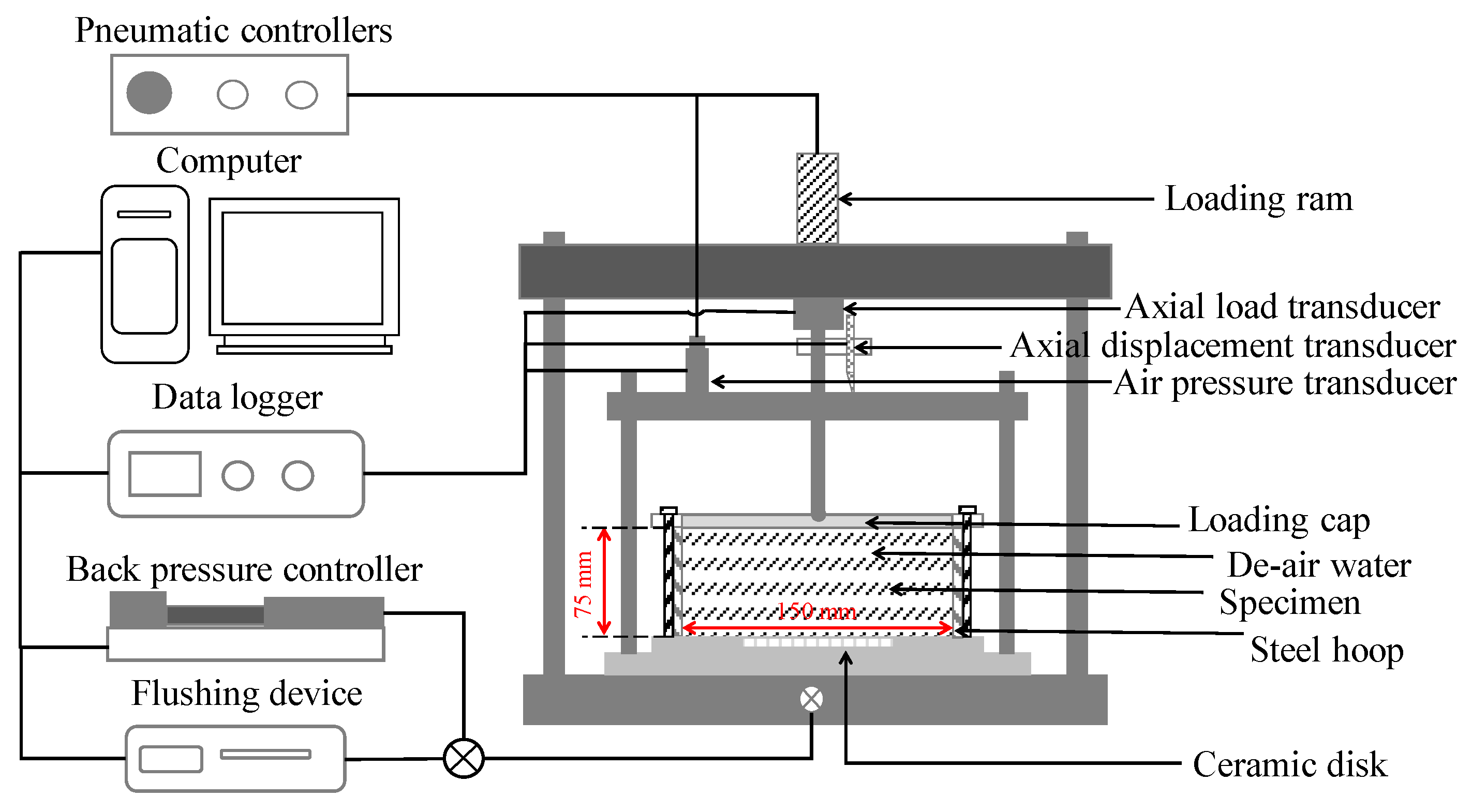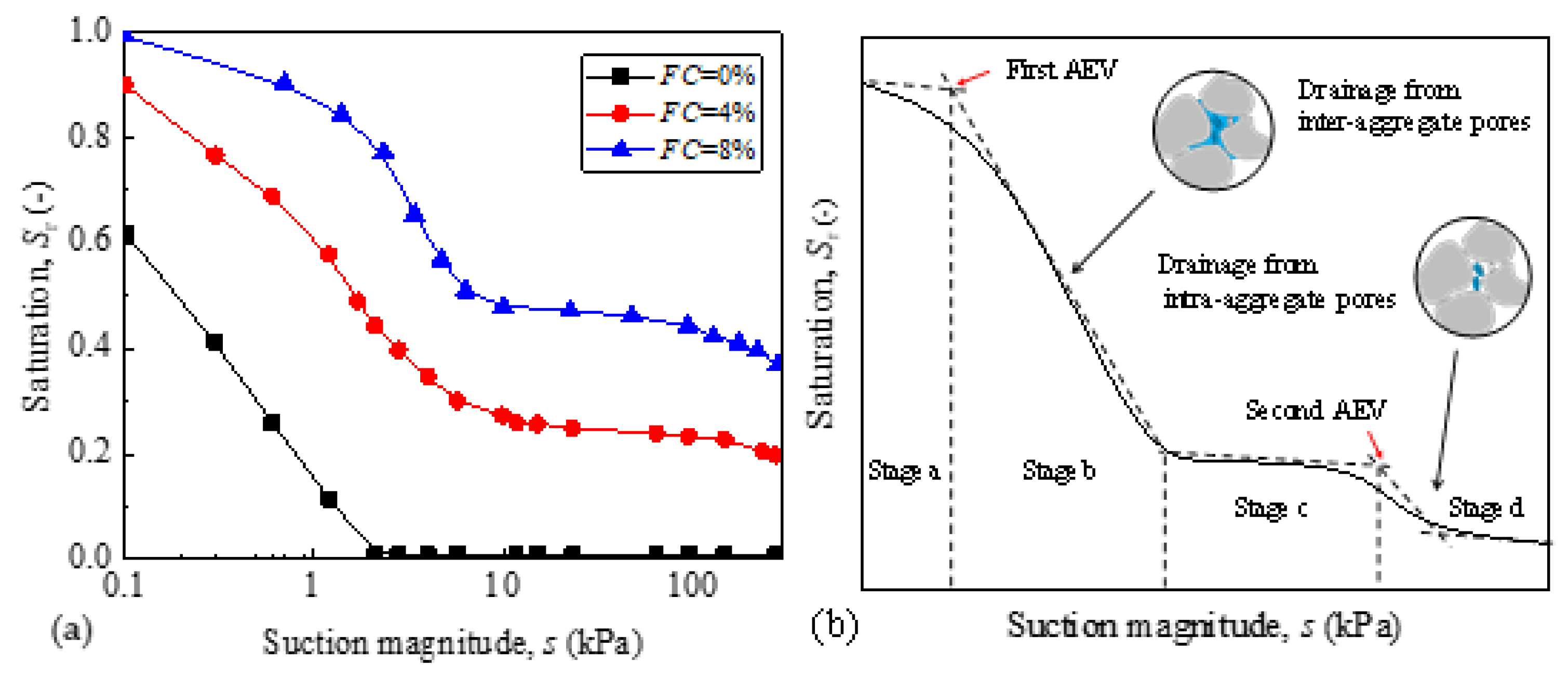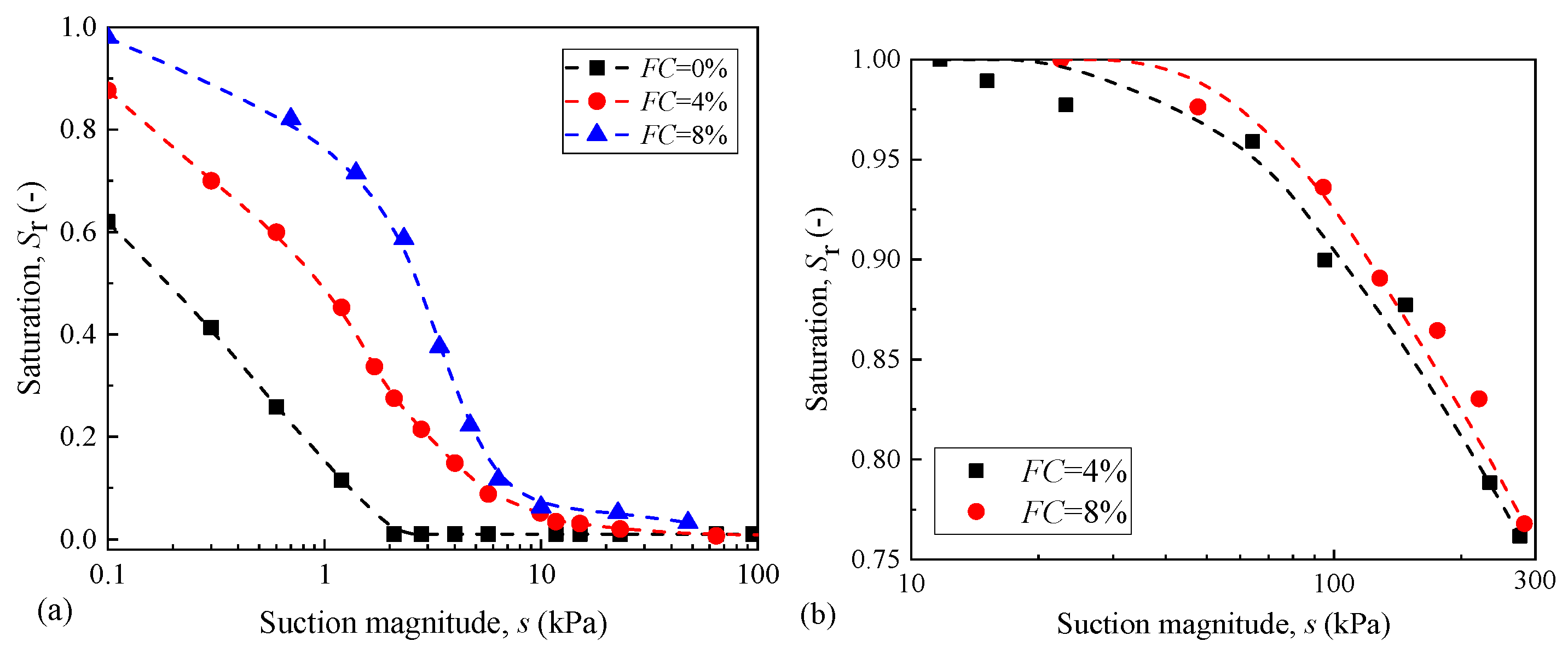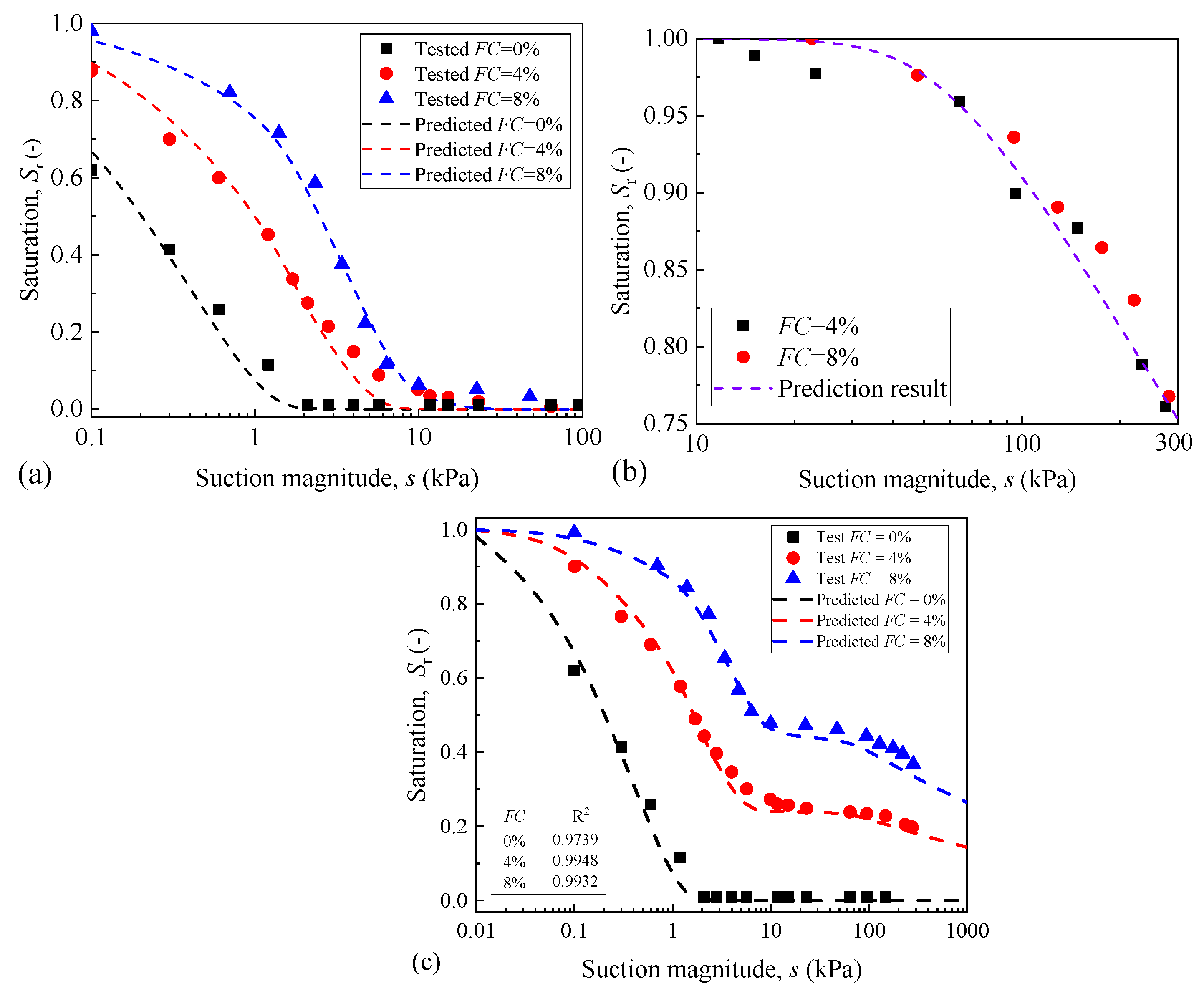Prediction of Soil–Water Retention Curves of Road Base Aggregate with Various Clay Fine Contents
Abstract
:1. Introduction
2. Materials and Methods
3. Effect of Fine Content on Soil Water Retention Curve and Pore Size Distribution
4. SWRC Model
5. Validation of the Proposed SWRC Model
6. Conclusions
Author Contributions
Funding
Institutional Review Board Statement
Informed Consent Statement
Data Availability Statement
Conflicts of Interest
Notation
| FC | fine content |
| s | matric suction |
| r | pore radius |
| Ts | surface tension of water and soil |
| contact angle | |
| volumetric water content | |
| pore size distribution (PSD) function | |
| shifting value | |
| scaling factor | |
| PSD of inter-aggregate pores | |
| PSD of intra-aggregate pores | |
| effective saturation of inter-aggregate pore | |
| effective saturation of intra-aggregate pore | |
| saturated volumetric water content of the inter-aggregate pores | |
| saturated volumetric water content of the intra-aggregate pores | |
| saturated volumetric water content of the soils | |
| k | fitting parameter |
| ; nf; mf | fitting parameter of the SWRC formed by intra-aggregate pores |
| ; nc; mc | fitting parameter of the SWRC formed by inter-aggregate pores |
| shifting parameter of the inter-aggregate pores | |
| scaling parameter of the intra-aggregate pores | |
| fitting parameter |
References
- Wang, H.-L.; Cui, Y.-J.; Lamas-Lopez, F.; Dupla, J.-C.; Canou, J.; Calon, N.; Saussine, G.; Aimedieu, P.; Chen, R. Effects of inclusion contents on resilient modulus and damping ratio of unsaturated track-bed materials. Can. Geotech. J. 2017, 54, 1672–1681. [Google Scholar] [CrossRef]
- Su, Y.; Cui, Y.-J.; Dupla, J.-C.; Canou, J. Investigation of the effect of water content on the mechanical behavior of track-bed materials under various coarse grain contents. Constr. Build. Mater. 2020, 263, 120206. [Google Scholar] [CrossRef]
- Su, Y.; Cui, Y.-J.; Dupla, J.-C.; Canou, J.; Qi, S. Developing a Sample Preparation Approach to Study the Mechanical Behavior of Unsaturated Fine/Coarse Soil Mixture. Geotech. Test. J. 2020, 44, 912–928. [Google Scholar] [CrossRef]
- Su, Y.; Cui, Y.-J.; Dupla, J.-C.; Canou, J. Effect of water content on resilient modulus and damping ratio of fine/coarse soil mixtures with varying coarse grain contents. Transp. Geotech. 2021, 26, 100452. [Google Scholar] [CrossRef]
- Duong, T.V.; Trinh, V.N.; Cui, Y.J.; Tang, A.M.; Calon, N. Development of a Large-Scale Infiltration Column for Studying the Hydraulic Conductivity of Unsaturated Fouled Ballast. Geotech. Test. J. 2013, 36, 54–63. [Google Scholar] [CrossRef]
- Su, Y.; Cui, Y.-J.; Dupla, J.-C.; Canou, J. Soil-water retention behaviour of fine/coarse soil mixture with varying coarse grain contents and fine soil dry densities. Can. Geotech. J. 2022, 59, 291–299. [Google Scholar] [CrossRef]
- Trinh, V.N.; Tang, A.M.; Cui, Y.-J.; Dupla, J.-C.; Canou, J.; Calon, N.; Lambert, L.; Robinet, A.; Schoen, O. Mechanical characterisation of the fouled ballast in ancient railway track substructure by large-scale triaxial tests. Soils Found. 2012, 52, 511–523. [Google Scholar] [CrossRef]
- Duong, T.V.; Tang, A.M.; Cui, Y.-J.; Trinh, V.N.; Dupla, J.-C.; Calon, N.; Canou, J.; Robinet, A. Effects of fines and water contents on the mechanical behavior of interlayer soil in ancient railway sub-structure. Soils Found. 2013, 53, 868–878. [Google Scholar] [CrossRef] [Green Version]
- Duong, T.V.; Cui, Y.-J.; Tang, A.M.; Dupla, J.-C.; Canou, J.; Calon, N.; Robinet, A. Effects of water and fines contents on the resilient modulus of the interlayer soil of railway substructure. Acta Geotech. 2016, 11, 51–59. [Google Scholar] [CrossRef]
- Cao, Z.; Chen, J.; Cai, Y.; Gu, C.; Wang, J. Effects of moisture content on the cyclic behavior of crushed tuff aggregates by large-scale tri-axial test. Soil Dyn. Earthq. Eng. 2017, 95, 1–8. [Google Scholar] [CrossRef]
- Zhao, H.; Zhang, L. Effect of coarse content on shear behavior of unsaturated coarse granular soils. Can. Geotech. J. 2014, 51, 1371–1383. [Google Scholar] [CrossRef]
- Gu, C.; Ye, X.; Cao, Z.; Cai, Y.; Wang, J.; Zhang, T. Resilient behavior of coarse granular materials in three dimensional anisotropic stress state. Eng. Geol. 2020, 279, 105848. [Google Scholar] [CrossRef]
- Vanapalli, S.K.; Fredlund, D.G.; Pufahl, D.E.; Clifton, A.W. Model for the prediction of shear strength with respect to soil suction. Can. Geotech. J. 1996, 33, 379–392. [Google Scholar] [CrossRef]
- Fredlund, D.G.; Xing, A.; Fredlund, M.; Barbour, S.L. The relationship of the unsaturated soil shear strength to the soil-water characteristic curve. Can. Geotech. J. 1996, 33, 440–448. [Google Scholar] [CrossRef]
- Chaney, R.; Demars, K.; Oberg, A.; Sällfors, G. Determination of Shear Strength Parameters of Unsaturated Silts and Sands Based on the Water Retention Curve. Geotech. Test. J. 1997, 20, 40. [Google Scholar] [CrossRef]
- Vanapalli, S.K.; Han, Z. Prediction of the resilient modulus of unsaturated fine-grained soils. In Proceedings of the International Conference on Advances in Civil Engineering, AETACE, New Delhi, India, 13–14 December 2013. [Google Scholar]
- Han, Z.; Vanapalli, S.K. Model for predicting resilient modulus of unsaturated subgrade soil using soil-water characteristic curve. Can. Geotech. J. 2015, 52, 1605–1619. [Google Scholar] [CrossRef]
- Han, Z.; Vanapalli, S.K. Relationship between resilient modulus and suction for compacted subgrade soils. Eng. Geol. 2016, 211, 85–97. [Google Scholar] [CrossRef]
- Baetens, J.M.; Verbist, K.; Cornelis, W.M.; Gabriels, D.; Soto, G. On the influence of coarse fragments on soil water retention. Water Resour. Res. 2009, 45, W07408. [Google Scholar] [CrossRef]
- Bicalho, K.V.; Gonçalves, F.V.; Favero, L.S. Evaluation of the Soil-Water Retention Curves of Different Unsaturated Silt-Sand Soil Mixtures. In PanAm Unsaturated Soils; American Society of Civil Engineers: Dallas, TX, USA, 2017; pp. 95–103. [Google Scholar] [CrossRef]
- Duong, T.V.; Cui, Y.-J.; Tang, A.M.; Dupla, J.-C.; Calon, N. Effect of fine particles on the hydraulic behavior of interlayer soil in railway substructure. Can. Geotech. J. 2014, 51, 735–746. [Google Scholar] [CrossRef]
- Trinh, V.N. Comportement Hydromécanique de Matériaux Constitutifs de Plateformes Ferroviaires Anciennes. Ph.D. Thesis, Université Paris-Est, Champs-sur-Marne, France, 2011. [Google Scholar]
- Hu, R.; Chen, Y.-F.; Liu, H.-H.; Zhou, C. A water retention curve and unsaturated hydraulic conductivity model for deformable soils: Consideration of the change in pore-size distribution. Géotechnique 2013, 63, 1389–1405. [Google Scholar] [CrossRef]
- Zhou, C.; Ng, C. A new and simple stress-dependent water retention model for unsaturated soil. Comput. Geotech. 2014, 62, 216–222. [Google Scholar] [CrossRef]
- Khoshghalb, A.; Pasha, A.; Khalili, N. A fractal model for volume change dependency of the water retention curve. Géotechnique 2015, 65, 141–146. [Google Scholar] [CrossRef]
- Tan, F.; Zhou, W.-H.; Yuen, K.-V. Modeling the soil water retention properties of same-textured soils with different initial void ratios. J. Hydrol. 2016, 542, 731–743. [Google Scholar] [CrossRef]
- Chen, R.-P.; Liu, P.; Liu, X.-M.; Wang, P.-F.; Kang, X. Pore-scale model for estimating the bimodal soil–water characteristic curve and hydraulic conductivity of compacted soils with different initial densities. Eng. Geol. 2019, 260, 105199. [Google Scholar] [CrossRef]
- Zhang, L.; Chen, Q. Predicting bimodal soil–water characteristic curves. J. Geotech. Geoenviron. Eng. 2005, 131, 666–670. [Google Scholar] [CrossRef]
- Zhao, H.F.; Zhang, L.M.; Fredlund, D.G. Bimodal Shear-Strength Behavior of Unsaturated Coarse-Grained Soils. J. Geotech. Geoenviron. Eng. 2013, 139, 2070–2081. [Google Scholar] [CrossRef]
- Li, X.; Li, J.; Zhang, L. Predicting bimodal soil–water characteristic curves and permeability functions using physically based parameters. Comput. Geotech. 2014, 57, 85–96. [Google Scholar] [CrossRef]
- Wijaya, M.; Leong, E. Equation for unimodal and bimodal soil–water characteristic curves. Soils Found. 2016, 56, 291–300. [Google Scholar] [CrossRef]
- 56000 Ft-Lbf/Ft3 (2700 KN-M/M3); Standard Test Methods for Laboratory Compaction Characteristics of Soil Using Modified Effort. ASTM STANDARDS: West Conshohocken, PA, USA, 2009.
- Thevanayagam, S. Effect of Fines and Confining Stress on Undrained Shear Strength of Silty Sands. J. Geotech. Geoenvironmental Eng. 1998, 124, 479–491. [Google Scholar] [CrossRef]
- Cao, Z.; Zhang, Q.; Cai, Y.; Chen, J.; Gu, C.; Wang, J. The effects of suction history on the cyclic behavior of unsaturated road base filling materials. Eng. Geol. 2020, 276, 105775. [Google Scholar] [CrossRef]
- ASTM D4959-16; Standard Test Method for Determination of Water Content of Soil by Direct Heating. ASTM International: West Conshohocken, PA, USA, 2016.
- Fredlund, D.; Xing, A. Equations for the soil-water characteristic curve. Can. Geotech. J. 1994, 31, 521–532. [Google Scholar] [CrossRef]
- Cheng, Q.; Ng, C.W.W.; Zhou, C.; Tang, C.S. A new water retention model that considers pore non-uniformity and evolution of pore size distribution. Bull. Eng. Geol. Environ. 2019, 78, 5055–5065. [Google Scholar] [CrossRef]
- Mualem, Y. A new model for predicting the hydraulic conductivity of unsaturated porous media. Water Resour. Res. 1976, 12, 513–522. [Google Scholar] [CrossRef] [Green Version]
- Van Genuchten, M.T. A Closed-form Equation for Predicting the Hydraulic Conductivity of Unsaturated Soils. Soil Sci. Soc. Am. J. 1980, 44, 892–898. [Google Scholar] [CrossRef] [Green Version]







| nc | mc | nf | mf | k | |||
|---|---|---|---|---|---|---|---|
| 1.1 × 10−5 | 1.174 | 2,781,837.05 | 0.015 | 3.48 | 0.054 | 2.36 | 0.0567 |
Publisher’s Note: MDPI stays neutral with regard to jurisdictional claims in published maps and institutional affiliations. |
© 2022 by the authors. Licensee MDPI, Basel, Switzerland. This article is an open access article distributed under the terms and conditions of the Creative Commons Attribution (CC BY) license (https://creativecommons.org/licenses/by/4.0/).
Share and Cite
Zhang, Q.; Cao, Z.; Gu, C.; Cai, Y. Prediction of Soil–Water Retention Curves of Road Base Aggregate with Various Clay Fine Contents. Appl. Sci. 2022, 12, 3624. https://doi.org/10.3390/app12073624
Zhang Q, Cao Z, Gu C, Cai Y. Prediction of Soil–Water Retention Curves of Road Base Aggregate with Various Clay Fine Contents. Applied Sciences. 2022; 12(7):3624. https://doi.org/10.3390/app12073624
Chicago/Turabian StyleZhang, Qi, Zhigang Cao, Chuan Gu, and Yuanqiang Cai. 2022. "Prediction of Soil–Water Retention Curves of Road Base Aggregate with Various Clay Fine Contents" Applied Sciences 12, no. 7: 3624. https://doi.org/10.3390/app12073624






